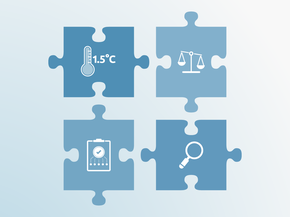Current Policy Projections
Economy-wide
US emissions are projected to decrease slightly until the early 2020s and then level off at between 6.4 and 6.5 GtCO2e/year by 2025 (excl. LULUCF), continuing in that range through 2030. This level of emissions in 2025 is equivalent to or slightly above (0–3%) 1990 levels of emissions, and only 11 to 13% below 2005 levels. Under this policy scenario, which includes current federal and state level policies, the US will not meet its (already weak) NDC target. The US is also unlikely to achieve its 2020 target of 13–17% below 2005 levels (excl. LULUCF), but is also not too far off—current policies are projected to result in emissions of 10 to 11% below 2005 levels in 2020 (excl. LULUCF).
Nevertheless, projected emissions in 2030 are lower than the CAT projected in 2017. The EIA’s Annual Energy Outlook 2018 (AEO) projects 7% lower emissions from electricity generation as compared to the 2017 outlook (reference case excluding CPP), with increased electricity generation from gas and renewables, decreased generation from coal, and decreased generation overall (U.S. Energy Information Administration, 2018a).
Coal is projected to account for 26% of generation in 2030, gas for 34%, and renewables for 23%, with nuclear making up the rest. Petroleum consumption in the transport sector is also projected to be lower, leading to additional emissions reductions. A methodological change in inventory data caused further reductions in projected emissions: 2017 inventory data is lower than 2016 data (1.8% in 2014), primarily due to methodological changes that impact CH4 and N2O. The CAT also includes the low economic growth scenario from the AEO in its analysis to better reflect the range of possible economic scenarios.
Since the beginning of 2018, the US Environmental Protection Agency (EPA) has proposed a weak replacement for the Clean Power Plan, has weakened methane emissions standards for oil and gas facilities, has proposed freezing emissions standards for light duty vehicles after 2020, and will not enforce measures to reduce HFC emissions. Depending on the outcome of legal action against some of these proposals, emissions could rise 110 to 185 MtCO2e/yr above the current policy scenario in 2030, which already excludes the Clean Power Plan (see footnote 1 and table in assumptions section). Conversely, increased state and local action, in addition to market pressures, may contribute to additional reductions. An analysis of recorded and quantified commitments from sub-national and non-state actors in the US suggests that these commitments, if implemented, could result in emissions reductions of 17–24% below 2005 levels in 2025 (incl. LULUCF), within striking distance of the US NDC target (America’s Pledge, 2018; Data Driven Yale, NewClimate Institute and PBL, 2018). These commitments are not included in the CAT current policy scenario.
Selected state level policies included in CAT projections
The CAT projections include a number of state level policies through the EIA’s Annual Energy Outlook. These include:
- California Global Warming Solutions Act of 2006 (SB32)
- California Assembly Bill 32 (AB32) – California’s cap and trade system
- California Advanced Clean Cars program including the Zero Emissions Vehicle program
- State Renewable Portfolio Standards – 29 states
- Northeast Regional Greenhouse Gas Initiative
- State motor fuels taxes
Historically, US emissions increased between 1990 and 2007. The financial crisis from 2008 saw emissions drop. In 2010 they began to increase again, but 2011 and 2012 saw a downward pressure, mainly resulting from a strong shift to natural gas as an energy source and a decrease in total energy demand. However, 2013 and 2014 again saw an increase in total GHG emissions, partially from an increase in coal consumption. Energy-related CO2 emissions declined in 2015 and 2016, due to a decrease in coal consumption (coal emissions decreased 8.6% in 2016) accompanied by a slight increase in oil and natural gas consumption (EIA, 2017). This is consistent with a generally declining trend over the past decade.
Energy supply
The Clean Power Plan (CPP), which the Obama Administration issued under the Clean Air Act, aimed to reduce emissions from the power sector by 32% below 2005 levels by 2030 by setting targets for each state individually. The successful implementation of the CPP would have been an important step in strengthening US climate action. However, in August 2018, the EPA proposed a replacement for the CPP that would limit the scope of the plan to emissions reductions inside the fence at individual power plants, for example through efficiency measures or carbon capture and storage technologies and allow states the ability to set their own rules (U.S. Environmental Protection Agency, 2018a). This is a significant departure from the CPP, which would have required entire states to meet emissions standards and is likely to result in emissions that are up to 81 MtCO2e/yr higher in 2025 and 212 MtCO2e/yr higher in 2030 than if the CPP had been fully implemented (U.S. Energy Information Administration, 2018a). At the subnational level, 29 states have mandatory renewable portfolio standards, and 9 have voluntary renewable energy targets. Five US cities have already achieved their goals of 100% renewable energy (America’s Pledge, 2017).
The emissions intensity of electricity generation in the US has been generally decreasing over the past 15 years, from a high point of 631 gCO2/kWh in 2001 to 455 gCO2/kWh in 2015. Renewables shares have been increasing over the same time period, and US government projections expect them to reach 23% in 2030 and 31% in 2050 (U.S. Energy Information Administration, 2018a). Bloomberg New Energy Finance projects much higher renewables shares of 55% in 2050 (BloombergNEF, 2018). On a global level, Paris Agreement compatibility requires a completely decarbonised electricity sector by 2050 (Climate Action Tracker, 2016). Utility scale solar PV installations were up 10% in the US in the first half of 2018 as compared to the first half of 2017 (Jan-Jun); coal plant retirements doubled. Onshore wind installations were down 44% as compared to the first half of 2017 (CAT analysis based on (U.S. Energy Information Administration, 2018b)).
The EPA and the Bureau of Land Management (BLM) have in the past set a series of standards to reduce emissions of volatile organic compounds and methane emissions from oil and gas production. However, the EPA has proposed to change emissions standards for new, reconstructed, and modified sources in the oil and natural gas sector, allowing methane leaks to continue for longer before they are found and fixed (U.S. Environmental Protection Agency, 2018b). The BLM has also delayed its methane reduction rule until at least 2019.
Industry
Through the Significant New Alternatives Policy (SNAP) programme, the Obama Administration prohibited the use of certain hydrofluorocarbons (HFCs) in various end uses in 2015, and specified acceptable alternatives. In April 2018, in light of a court ruling, the EPA announced that it would not enforce the 2015 rule, allowing these HFCs to continue to be used (U.S. Environmental Protection Agency, 2018c). The original rule was estimated to reduce emissions by 54–64 MtCO2e/yr in 2025 and by 78–101 MtCO2e/yr in 2030 in comparison to a business as usual scenario (U.S. Environmental Protection Agency, 2015). HFCs are among the world’s most potent greenhouse gases, with warming potentials hundreds of times higher than CO2. To meet the requirements of the Kigali Amendment of the Montreal Protocol, which the US has not yet ratified, it would need to implement more stringent standards than the SNAP programme.
Transport
In passenger transport, the Corporate Average Fuel Economy (CAFE) standards for Light Duty Vehicles limit greenhouse gas emissions from cars and trucks through fuel efficiency and were set through 2025 under the Obama Administration. In August 2018, the EPA and National Highway Safety Administration (NHTSA) proposed a replacement rule that would freeze standards at 2020 values, instead of requiring more stringent standards over time (U.S. Environmental Protection Agency, Administration and U.S. National Highway Saftey Administration, 2018). CAT calculations suggest that this could result in emissions increases of 22 MtCO2e/yr in 2025 and 76 MtCO2e/yr in 2030 (Climate Action Tracker, 2017). California has announced that it will maintain the standards, and, together with 16 other states, filed a lawsuit in May 2018 against the Trump Administration’s plans to roll them back (McGreevy and Halper, 2018).
Some states have further programmes to reduce emissions from LDVs, such as California’s Advanced Clean Cars programme. Ten states have Zero Emissions Vehicle targets (America’s Pledge, 2017), and electric vehicles reached 2% of new vehicle sales nationwide in July 2018 (Kane, 2018). In San Jose, California, 13% of all new vehicles sold in 2017 were electric (Lutsey, 2018). On a global level, the last fossil fuel powered car will need to be sold by 2035 for Paris Agreement compatibility (Climate Action Tracker, 2016).
In freight transport, the Heavy-Duty Vehicle National Program sets greenhouse gas emissions and fuel efficiency standards for heavy-duty vehicles (U.S. Environmental Protection Agency and U.S. National Highway Safety Administration, 2016).
Buildings
The US has numerous federal and state level policies in the buildings sector, primarily focused on energy efficiency. These include the National Appliance Energy Conservation Act of 1987, with appliance standards that have been updated as recently as 2015, and the Energy Policy Act of 1992 and 2005, which includes whole house efficiency minimums. In addition, the government provides certain tax credits for energy efficient appliances, and the EPA runs the Energy Star program, which uses a voluntary labelling system to increase consumer awareness of energy efficiency.
The US does not have federal targets for expanding net zero energy buildings (nZEBs), although the states of California and Massachusetts do. This is in contrast to the EU, for example, which requires all new buildings to be nZEBs starting in 2020. For Paris Agreement-compatibility, all new buildings globally should be nZEBs starting in 2020, and renovation rates should increase to 3–5% per year (Climate Action Tracker, 2016).
Agriculture
The US Department of Agriculture (USDA)’s “Building Blocks for Climate Smart Agriculture & Forestry” foresees a set of voluntary activities involving farmers and companies (USDA, 2015). The measures target reductions in emissions from agriculture (e.g. improved fertiliser use and other agricultural practices, avoiding methane from livestock) and land use and forestry (e.g. improved soil management, avoid deforestation and reforestation).
Forestry
The achievement of the mitigation targets can also depend on the level of sinks coming from LULUCF: the 6th National Communication, used in the CAT analysis, projects that the US LULUCF sector’s sinks will absorb between 0.614 and 0.898 GtCO2e/year in 2020 (10–17% of NDC target), 0.573 and 0.917 GtCO2e/year in 2025 (10–17% of NDC target), and 0.565 and 0.937 GtCO2e/year in 2030 (10–18% of NDC target) (United States of America, 2014). The 2nd Biennial Report revises these numbers, predicting LULUCF sinks of between 1.044 and 1.191 GtCO2e/year in 2020 (18–22% of NDC target), 0.908 to 1.201 GtCO2e/year in 2025 (16–23% of NDC target), and 0.689 to 1.118 GtCO2e/year in 2030 (12–21% of NDC target). These higher values would make it easier to achieve the NDC target. There is high uncertainty in these projections, and the final level in future years could have an impact on whether the targets will be achieved. If the sink becomes larger than expected in the projections, it will be easier to meet the target. If the sink becomes smaller, even more policies in non-LULUCF sectors would be required.
Waste
The EPA finalised standards to reduce methane emissions from new, modified, and reconstructed municipal solid waste landfills in 2016. In May, 2017, the EPA stayed the standards for 90 days, and is currently reconsidering the standards, although they are in effect (EPA, 2017).
Further analysis
Latest publications
Stay informed
Subscribe to our newsletter






